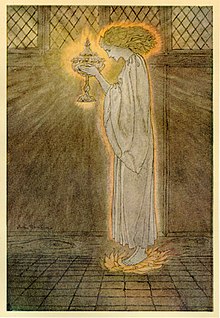จอกศักดิ์สิทธิ์

จอกศักดิ์สิทธิ์ (อังกฤษ: Holy Grail) เป็นภาชนะซึ่งเป็นแกนเรื่องสำคัญในวรรณกรรมอาเธอร์ ตำนานหลายเรื่องพรรณนาว่า เป็นถ้วย ชาม หรือศิลา ซึ่งมีอำนาจเหนือธรรมชาติบันดาลให้เกิดความสุข ความเยาว์วัยชั่วนิรันดร์ หรือชีวิตอมตะ คำว่า "จอกศักดิ์สิทธิ์" ยังมักใช้เรียกสิ่งของหรือเป้าหมายที่ไขว่คว้าหากันเพราะเชื่อว่า มีความสำคัญยิ่งยวด[1]
การกล่าวถึง "จอก" วิเศษ แม้ไม่ปรากฏชัดว่า ศักดิ์สิทธิ์ด้วยหรือไม่นั้น ปรากฏครั้งแรกในนิยายวีรคติอัศวินเรื่อง แปร์เซอวาลเลอกงต์ดูกราล (Perceval, le Conte du Graal; "แปร์เซอวาลตำนานจอก") ผลงานซึ่งเขียนไม่เสร็จของเครเตียง เดอ ทรัว (Chrétien de Troyes) ในราว ค.ศ. 1190[2] ในเอกสารนี้ ภาชนะดังกล่าวเป็น "ถาด" (salver) สำหรับเชิญอาหารในงานเลี้ยง[3] เอกสารของเครเตียงนำไปสู่การเล่าต่อ แปลความ และตีความ อีกมากมายในช่วงปลายคริสต์ศตวรรษที่ 12 จนต้นคริสต์ศตวรรษที่ 13 ในจำนวนนี้รวมถึงผลงานของวอลฟรัม ฟอน เอสเชนบัค (Wolfram von Eschenbach) ซึ่งเข้าใจไปว่า "จอก" เป็น "ศิลา"[4] ในปลายคริสต์ศตวรรษที่ 12 นั้นเอง โรแบร์ เดอ โบรง (Robert de Boron) เขียนผลงานชื่อ โฌเซฟดารีมาตี (Joseph d'Arimathie) ว่า จอกนี้เป็นภาชนะที่พระเยซูทรงใช้เสวยพระกระยาหารมื้อสุดท้าย แล้วโยเซฟชาวอาริมาเธียใช้รองพระโลหิตของพระองค์ขณะทรงถูกตรึงกางเขน หลังจากนั้น เรื่องราวของจอกศักดิ์สิทธิ์ก็ผสมปนเปไปกับตำนานเรื่องถ้วยศักดิ์สิทธิ์ (Holy Chalice) อันเป็นภาชนะในพระกระยาหารมื้อสุดท้าย[5]
นักวิชาการสันนิษฐานกันมานานแล้วว่า เครเตียงไม่ใช่คนแรกที่คิดค้นเรื่องจอกศักดิ์สิทธิ์เป็นแน่ เพราะเนื้อเรื่องดูจะมีองค์ประกอบจากตำนานเรื่องหม้อกายสิทธิ์ในเทพปกรณัมเคลต์ประสมกับตำนานในศาสนาคริสต์ซึ่งเกี่ยวข้องกับพิธีมหาสนิท[6] โดยเฉพาะตำนานเรื่องหลังนี้พบมากในแหล่งข้อมูลจากคริสตจักรตะวันออก และแม้กระทั่งในแหล่งข้อมูลจากเปอร์เซีย[7]
ศัพทมูล
[แก้]ในภาษาอังกฤษ คำว่า "grail" ที่แปลว่า จอก นั้น เดิมสะกด "graal" มาจากคำว่า "graal" หรือ "greal" ในภาษาฝรั่งเศสเก่า ซึ่งร่วมที่มากับคำว่า "grazal" ในภาษาอุตซิตาเก่า และ "gresal" ในภาษากาตาลาเก่า มีความหมายว่า "ถ้วยหรือชามทำจากดิน ไม้ หรือโลหะ" ในภาษาถิ่นอุตซิตายังสามารถหมายถึงภาชนะอย่างอื่นอีกหลายประเภท[8]
อย่างไรก็ดี รากเหง้าซึ่งเป็นที่ยอมรับกันมากที่สุดสำหรับคำนี้ ได้แก่ คำนี้มาจากภาษาละตินว่า "gradalis" หรือ "gradale" โดยรับมาผ่านการสะกดแบบเดิม คือ "cratalis" ซึ่งแผลงมาจาก "crater" หรือ "cratus" ที่ยืมมาจากภาษากรีกว่า "krater" (κρατήρ) แปลว่า ภาชนะขนาดใหญ่ใช้ผสมเหล้า[8][9][10][11][12]
ข้อสันนิษฐานอื่นระบุว่า คำนี้แผลงมาจาก "cratis" ซึ่งเดิมแปลว่า ตระกร้าสาน และภายหลังใช้เรียก จานชาม[13] หรืออาจแผลงมาจาก "gradus" ในภาษาละติน ที่แปลว่า ทีละน้อย ทีละขั้น หรือเป็นช่วง ๆ โดยนำมาเรียกจานที่ค่อย ๆ นำมาวางบนโต๊ะเป็นช่วง ๆ ไปในระหว่างการรับประทานอาหาร[14]
นักประพันธ์ในปลายมัชฌิมยุคอย่างทอมัส แมเลอรี (Thomas Malory) เสนอแนวคิดอันน่าตื่นตาตื่นใจเกี่ยวกับที่มาของคำ "san-graal" หรือ "san-gréal" ในภาษาฝรั่งเศสเก่า ซึ่งแปลว่า จอกศักดิ์สิทธิ์นั้น ว่า มาจาก "sang real" ที่แปลว่า พระโลหิต[15]
อ้างอิง
[แก้]- ↑ Merium-Webster. "Definition of Holy Grail". Merium-Webster. สืบค้นเมื่อ December 18, 2017.
- ↑ Loomis, Roger Sherman (1991). The Grail: From Celtic Myth to Christian Symbol เก็บถาวร 2020-04-07 ที่ เวย์แบ็กแมชชีน. Princeton. ISBN 0-691-02075-2
- ↑ Staines, David.(Trans.) The Complete Romances of Chrétien de Troyes. Indiana University Press, Bloomington & Indianapolis, 1990, page 380.
- ↑ Von Eschenbach, Wolfram. Parzival. Hatto, A.T. translator. Penguin Books, 1980, page 239.
- ↑ Campbell, Joseph. Transformations of Myth Through Time. Harper & Row Publishers, New York, 1990, page 210.
- ↑ Weston, Jessie L. From Ritual To Romance. Princeton University Press, Princeton, New Jersey, 1993 (originally published 1920) p.74 & p.129,
- ↑ Jung, Emma and von Franz, Marie-Louise. The Grail Legend, Sigo Press, Boston, 1980, p. 14.
- ↑ 8.0 8.1 Diez, Friedrich. An etymological dictionary of the Romance languages, Williams and Norgate, 1864, p. 236.
- ↑ Nitze, William A. Concerning the Word Graal, Greal, Modern Philology, Vol. 13, No. 11 (Mar., 1916), pp. 681-684 .
- ↑ Jung, Emma and von Franz, Marie-Louise. The Grail Legend, Princeton University Press, 1998, pp. 116-117.
- ↑ Skeat, Walter William. Joseph of Arimathie, Pub. for the Early English Text Society, by N. Trübner & Co., 1871, pp. xxxvi-xxxvii
- ↑ Mueller, Eduard. Etymologisches Wörterbuch der englischen Sprache: A-K, chettler, 1865, p. 461.
- ↑ Barber, Richard. The Holy Grail: imagination and belief, Harvard University Press, 2004, p. 93.
- ↑ Richard O'Gorman, "Grail" in Norris J. Lacy, The Arthurian Encyclopedia, 1986
- ↑ Barber, Richard, The Holy Grail: Imagination and Belief, Harvard University Press, 2004, p. 215.
ดูเพิ่ม
[แก้]- ทวนศักดิ์สิทธิ์
- ตะปูศักดิ์สิทธิ์
- หีบแห่งพันธสัญญา
แหล่งข้อมูลอื่น
[แก้]- จอกศักดิ์สิทธิ์ จากโครงการคาเมล็อต
- The Holy Grail จาก Catholic Encyclopedia
ตำนานพระเจ้าอาร์เทอร์ | |
|---|---|
| ตัวละครหลัก |
|
| อัศวินโต๊ะกลม |
|
| สถานที่ |
|
| อื่น ๆ |
|
Text is available under the CC BY-SA 4.0 license; additional terms may apply.
Images, videos and audio are available under their respective licenses.
